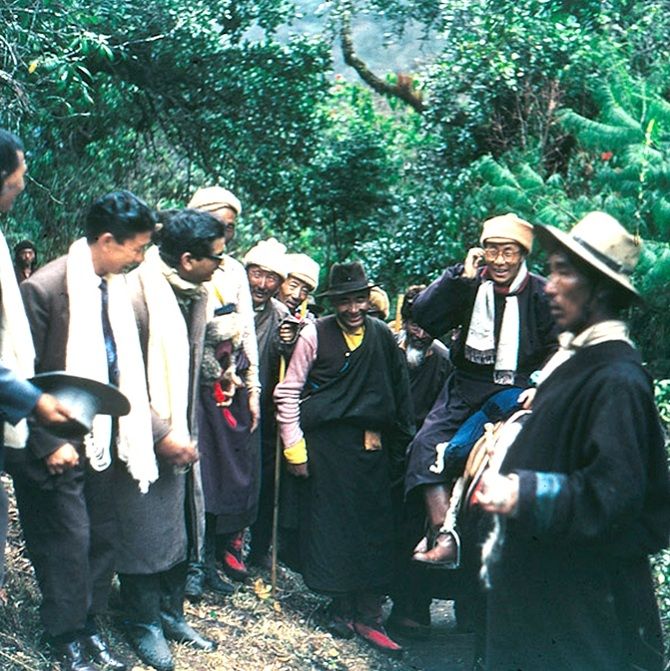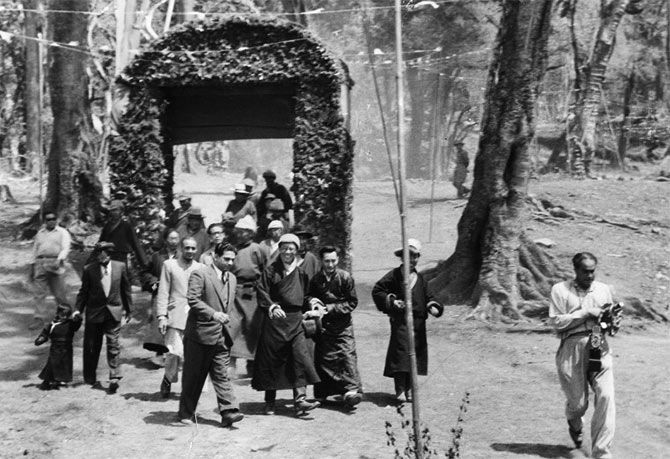The Tibetan spiritual leader's upcoming visit to Tawang, the district through which he first entered India, is probably behind China's new desire to claim the area.
Claude Arpi recalls the Dalai Lama's arrival in Tawang in March 1959 and explains why His Holiness will once again receive a grand welcome, whether Beijing likes it or not.

China often double-speaks.
At a press conference, a day before the opening of the National People's Congress, Fu Ying, the articulate spokesperson of the Chinese legislature, said that China and India, which have over the past decades witnessed rapid development of bilateral trade, should focus on enhancing mutual understanding and boosting cooperation rather than dwelling on disputes.
She forgot that just a few days earlier, Beijing planted a controversy in the Indian media. One newspaper wrote, 'China ready to cede land for part of Arunachal Pradesh?'
China wanted Tawang back.
'This could pave the way for a settlement of the India-China boundary dispute,' said Dai Bingguo, one of the senior-most Chinese diplomats under then president Hu Jintao.
The article does not mention that it is the same Dai, who drafted the agreement between India and China 'On the Political Parameters and Guiding Principles for the Settlement of the India-China Boundary Question' in 2005.
Had Dai, the then Special Representative for the border negotiations with India, forgotten the content of the 2005 agreement which referred to Tawang: 'In reaching a boundary settlement, the two sides shall safeguard due interests of their settled populations in the border areas.'
It clearly meant that the Tawang area, which is heavily populated, would not be ceded or exchanged.
This is what China had agreed to then.
The Dalai Lama's upcoming visit to Tawang is probably the reason for this new sudden claim.
Though time and again India has said that the Dalai Lama is an honoured guest in India and is free to go wherever he wants, Beijing aggressively threatened India with dire consequences if the Tibetan leader is allowed to visit the area.
More interesting than endlessly arguing with China is to look at some historical facts.
That 1959 journey

On March 17, 1959, the Dalai Lama left Lhasa in the dead of night under dramatic circumstances.
On March 26, 1959, he reached Lhuntse Dzong, a few days march from the McMahon Line, the border between India and Tibet.
The Tibetan temporal leader wrote to the Indian prime minister to seek refuge in India: 'Ever since Tibet went under the control of Red China and the Tibetan Government lost its powers in 1951, I, my Government officers and citizens have been trying to maintain peace in Tibet, but the Chinese Government has been gradually subduing the Tibetan Government.'
'In this critical situation we are entering India via Tsona,' the Dalai Lama added. 'I hope that you will please make necessary arrangements for us in the Indian territory. Confident of your kindness.'
Tsona is the last town, north of the border.
Upon receiving the message, Delhi took immediately measures to welcome the Tibetan leader and receive the party (his close family, four of his Cabinet ministers and some attendants and bodyguards) at the first Indian post at Chuthangmu, north of Tawang, then part of the Kameng Frontier Division.
Jawaharlal Nehru replied to the Dalai Lama: 'My colleagues and I welcome you and send you greetings on your safe arrival in India. We shall be happy to afford the necessary facilities for you, your family and entourage to reside in India. The people of India who hold you in great veneration will no doubt accord their traditional respect to your person.'
Since that day, the Indian government and people have considered the Dalai Lama an honoured guest in the Land of the Buddha.

I have recently come across a 'Top Secret report on the entry of His Holiness the Dalai Lama into India'; it describes the epic arrival of the Dalai Lama in India.
There was no doubt for anybody (including Beijing) that Chuthangmu/Khenzimane, on the McMahon Line was (and is) the border, with areas south being part of Indian territory.
The report said: 'On the March 27, 1959, Shri T S Murthy, Assistant Political Officer [APO], Tawang, received instructions about the possibility of the Dalai Lama seeking entry into India. He reached Chuthangmu to receive the party at 0900 hours on the March 31.'
At that time the Assam Rifles post was located four or five days walk north of Tawang, famous for having the largest Indian Buddhist monastery.
On March 29, an advance party, under a junior Tibetan officer, reached Chuthangmu. The Assam Rifles platoon was informed that the main party 'was expected to enter our territory at 1400 hours on March 31, (and) that there was no sign of the Chinese pursuit.'
The messengers carried the original letter of the Dalai Lama's letter to Nehru, which was translated and transmitted to Shillong and Delhi via wireless.
At the appointed time, 'the Dalai Lama and his party reached Khenzimane, which demarcates the frontier in Chuthangmu area. His Holiness was riding a yak and was received by the APO, Tawang (Murthy). They proceeded to the check post without halting at the frontier.'
The Tibetans knew where the border was. Everyone in the party was so relieved that the Dalai Lama was now safe in India.
In the evening, when the Lord Chamberlain met the APO 'it was agreed that all porters brought by the party from Tibet would be sent back and that porterage arrangements thereafter would be made by us.'
'It was also agreed that all pistols and revolvers, except those in possession of the Dalai Lama, his family and ministers (excluding their servants), and all rifles would be handed over to us for safe custody,' noted the report.
A list of the members of the party was given to Murthy, a Chinese-speaking officer.

The next day at 9 am, the APO was summoned by the Dalai Lama.
The circumstances of the flight were discussed: 'The policy of the Chinese was becoming increasingly anti-religious; the masses of Tibet were restive and he was no longer able to make them put up with the Chinese rule; the Chinese had attempted to endanger his person; Tibet should be free; his people would fight to win their freedom; he was confident that India's sympathies are with the Tibetans.'
On April 2, the party moved to Gorsam Chorten (Stupa) located near Ziminthang, south of the border.
At 3 pm, the Dalai Lama called Murthy again, he was curious to know 'if he had received any news of international developments in regard to his escape, especially the line adopted by India, the UK and the USA in this regard. The APO said that he had no information.

Menon's son Shivshankar Menon later became India's Foreign Secretary and National Security Adviser.
The next day the party moved to Shakti.
After crossing the main bridge, they proceeded on the other side of the Namjiang chu river; the party accompanied by the Assam Rifles finally reached Lumla, the first large village between the border and Tawang on April 3.
Har Mander Singh, the Political Officer responsible for the Kameng Frontier Division, had left Tawang in the morning and reached Lumla in the evening: 'The mother, sister and 12-year-old brother of the Dalai Lama accompanied by 12 servants had reached Lumla from the other side a couple of hours ahead of us. I called on the mother and assured her of Government's protection,' noted Har Mander Singh.
The PO further reported: 'I received him (the Dalai Lama) and took him to his room. We discussed about his journey beyond Lumla.'
Singh took the opportunity to acquaint himself with the Dalai Lama's senior officers and personal staff: 'Two of the three Shapes (ministers) who are accompanying the Dalai Lama arrived in the afternoon. The third Shape who is accompanied by his family and the two tutors of the Dalai Lama are travelling a stage behind.'
As the PO held his first formal meetings with the Tibetan ministers, a messenger brought a letter from a Bhutanese official posted in Tashigong not far from Lumla, in Bhutan.
The missive stated that Bhutan was prepared to allow the Dalai Lama to pass through Tashigong district.
Singh remarks: 'I was rather taken aback to find that the Officer Commanding (of the local police platoon) had apparently been in touch with the Bhutan authorities to obtain passage for the Dalai Lama through (Bhutan.'
It was later found that the OC had 'exceeded his authority and gone over the PO's/APO's heads.'

On April 4, a ceremony was organized in the morning for the Dalai Lama to bless the local Monpa population of Lumla area.
After the ceremony, Singh went to the Dalai Lama's room.
To save face, the Bhutanese officials asked for an audience to say that in fact 'it would be preferable if His Holiness would travel through the Indian territory during his entire journey.' That settled the issue.
The entire party left Lumla at 8 am: 'During the journey the Dalai Lama asked questions about the tribes in the Division, the schools and the system of education, agriculture and self-sufficiency and medium of instructions to which I replied suitably,' wrote Har Mander Singh.
When he was alone with the PO, the Dalai Lama asked him, 'Although it was a delicate matter for India, he would like us to consider whether it was possible to give any kind of help to the Khampas and Tibetan troops fighting for the Tibetan cause.'
The PO answered that India was always prepared to give first aid to the injured and the sick at the border check-posts: 'The Government is sympathetically inclined towards genuine refugees, particularly women and children seeking asylum in India.'
The Dalai Lama informed the PO that he would like to spend a few days in Tawang and 'a much longer period in Bomdila to recuperate from the strain of his journey before going down to the plains.'
Har Mander Singh readily agreed.

On April 5, the Dalai Lama told the PO that he had learnt from the radio that 'fighting had broken out between the Chinese and the Khampas some 60 miles South of Lhasa. This area was inaccessible to the mechanized transport and was ideal for guerilla type of warfare. He was, therefore, confident that the Chinese would not be able to over-power the Khampas in this area.'
The party, which left at 7 am, attended the reception arranged by the Tawang Monastery en route and arrived in Tawang at noon.
The rest is history.

In Tawang, the Dalai Lama was given a guard of honour by the Assam Rifles, and could finally rest.
Though the guard of honour infuriated the Chinese, they did not mention that Tawang was 'Chinese territory'.
It is only much later that Beijing started claiming these areas as Chinese. This was clearly an afterthought, a bargaining chip for their occupation of the Aksai Chin plateau.
As he arrives in Tawang 58 years later, the Dalai Lama will again receive a grand welcome, whether Beijing likes it or not.
The people of India still hold him in great veneration.
Don't Miss: Rediff.com's exclusive insights into the Dalai Lama










 © 2025
© 2025